Enhanced Artificial Immune Systems and Fuzzy Logic for Active Distribution Systems Reconfiguration
Abstract
1. Introduction
2. Artificial Immune Systems
3. Fuzzy Logic
4. Distribution System Reconfiguration
4.1. Distribution Systems Power Flow
4.2. Graph Theory
4.3. Objective Functions
4.3.1. Power Loss Reduction
4.3.2. Load Balancing Function
4.3.3. Voltage Drop Function
4.4. Problem Formulation
5. Proposed Algorithm
5.1. Algorithm Flowchart
5.2. Cloning-Hypermutation Proposal
- It extracts the values of the currents of the formed loop from the previous equilibrium point in the last configuration (the antibody without applying the mutation).
- The opening of one of the switches of is performed according to the probability given in Equation (14).
- The successive application of mutations is carried out according to (15). For this case, from the second consecutive mutation, the opening probability is the same for all the switches.
5.3. Example of Cloning-Hypermutation Proposal
5.3.1. High-Affinity Individual Given by
5.3.2. Low-Affinity Antibody Given by
6. Simulations
6.1. Bus System
6.2. 84-Bus System
6.3. 136 Bus System
6.4. Multi-Objective Approach with Fuzzy Logic to the 136-Bus System
7. Conclusions
Author Contributions
Funding
Data Availability Statement
Conflicts of Interest
References
- Duan, D.-L.; Ling, X.-D.; Wu, X.-Y.; Zhong, B. Reconfiguration of distribution network for loss reduction and reliability improvement based on an enhanced genetic algorithm. Int. J. Electr. Power Energy Syst. 2015, 64, 88–95. [Google Scholar] [CrossRef]
- Abdelaziz, M. Distribution network reconfiguration using a genetic algorithm with varying population size. Electr. Power Syst. Res. 2017, 142, 9–11. [Google Scholar] [CrossRef]
- Alonso, F.R.; Oliveira, D.Q.; de Souza, A.C.Z. Artificial Immune Systems Optimization Approach for Multiobjective Distribution System Reconfiguration. IEEE Trans. Power Syst. 2014, 30, 840–847. [Google Scholar] [CrossRef]
- SSouza, S.S.; Romero, R.; Pereira, J.; Saraiva, J.T. Artificial immune algorithm applied to distribution system reconfiguration with variable demand. Int. J. Electr. Power Energy Syst. 2016, 82, 561–568. [Google Scholar] [CrossRef]
- Ferrero, S.; Freschi, F.; Pons, E.; Repetto, M. Application of vector immune system to distribution network reconfiguration. Int. J. Numer. Model. Electron. Netw. Devices Fields 2017, 32, e2262. [Google Scholar] [CrossRef]
- Qi, Q.; Wu, J.; Long, C. Multi-objective operation optimization of an electrical distribution network with soft open point. Appl. Energy 2017, 208, 734–744. [Google Scholar] [CrossRef]
- Li, Z.; Jazebi, S.; de Leon, F. Determination of the Optimal Switching Frequency for Distribution System Reconfiguration. IEEE Trans. Power Deliv. 2016, 32, 2060–2069. [Google Scholar] [CrossRef]
- Gutiérrez-Alcaraz, G.; Tovar-Hernández, J.H. Two-stage heuristic methodology for optimal reconfiguration and Volt/VAr control in the operation of electrical distribution systems. IET Gener. Transm. Distrib. 2017, 11, 3946–3954. [Google Scholar] [CrossRef]
- Kothona, D.; Bouhouras, A.S. A Two-Stage EV Charging Planning and Network Reconfiguration Methodology towards Power Loss Minimization in Low and Medium Voltage Distribution Networks. Energies 2022, 15, 3808. [Google Scholar] [CrossRef]
- Durango-Flórez, M.; González-Montoya, D.; Trejos-Grisales, L.A.; Ramos-Paja, C.A. PV Array Reconfiguration Based on Genetic Algorithm for Maximum Power Extraction and Energy Impact Analysis. Sustainability 2022, 14, 3764. [Google Scholar] [CrossRef]
- Yang, B.; Zeng, C.; Li, D.; Guo, Z.; Chen, Y.; Shu, H.; Cao, P.; Li, Z. Improved immune genetic algorithm based TEG system reconfiguration under non-uniform temperature distribution. Appl. Energy 2022, 325, 119691. [Google Scholar] [CrossRef]
- Kumar, P.; Ali, I.; Thomas, M.S.; Singh, S. Imposing voltage security and network radiality for reconfiguration of distribution systems using efficient heuristic and meta-heuristic approach. IET Gener. Transm. Distrib. 2017, 11, 2457–2467. [Google Scholar] [CrossRef]
- Nguyen, T.T.; Nguyen, T.T.; Truong, A.V.; Nguyen, Q.T.; Phung, T.A. Multi-objective electric distribution network reconfiguration solution using runner-root algorithm. Appl. Soft Comput. 2017, 52, 93–108. [Google Scholar] [CrossRef]
- Ahmadi, H.; Marti, J.R. Distribution System Optimization Based on a Linear Power-Flow Formulation. IEEE Trans. Power Deliv. 2014, 30, 25–33. [Google Scholar] [CrossRef]
- López, J.C.; Lavorato, M.; Rider, M.J. Optimal reconfiguration of electrical distribution systems considering reliability indices improvement. Int. J. Electr. Power Energy Syst. 2016, 78, 837–845. [Google Scholar] [CrossRef]
- Pareja, L.A.G.; López-Lezama, J.M.; Carmona, O.G. A Mixed-Integer Linear Programming Model for the Simultaneous Optimal Distribution Network Reconfiguration and Optimal Placement of Distributed Generation. Energies 2022, 15, 3063. [Google Scholar] [CrossRef]
- Ferdavani, A.K.; Zin, A.A.M.; Khairuddin, A.; Naeini, M.M. Reconfiguration of distribution system through two minimum-current neighbour-chain updating methods. IET Gener. Transm. Distrib. 2013, 7, 1492–1497. [Google Scholar] [CrossRef]
- Kazemi-Robati, E.; Sepasian, M.S. Fast heuristic methods for harmonic minimization using distribution system reconfiguration. Electr. Power Syst. Res. 2020, 181, 106185. [Google Scholar] [CrossRef]
- Narimani, M.R.; Vahed, A.A.; Azizipanah-Abarghooee, R.; Javidsharifi, M. Enhanced gravitational search algorithm for multi-objective distribution feeder reconfiguration considering reliability, loss and operational cost. IET Gener. Transm. Distrib. 2014, 8, 55–69. [Google Scholar] [CrossRef]
- Pamshetti, V.B.; Singh, S.; Singh, S.P. Combined Impact of Network Reconfiguration and Volt-VAR Control Devices on Energy Savings in the Presence of Distributed Generation. IEEE Syst. J. 2020, 14, 995–1006. [Google Scholar] [CrossRef]
- Akrami, A.; Doostizadeh, M.; Aminifar, F. Optimal Reconfiguration of Distribution Network Using μ PMU Measurements: A Data-Driven Stochastic Robust Optimization. IEEE Trans. Smart Grid 2019, 11, 420–428. [Google Scholar] [CrossRef]
- Shaheen, A.M.; El-Sehiemy, R.A.; Kamel, S.; Elattar, E.E.; Elsayed, A.M. Improving Distribution Networks’ Consistency by Optimal Distribution System Reconfiguration and Distributed Generations. IEEE Access 2021, 9, 67186–67200. [Google Scholar] [CrossRef]
- de Castro, L.; Von Zuben, F. Learning and optimization using the clonal selection principle. IEEE Trans. Evol. Comput. 2002, 6, 239–251. [Google Scholar] [CrossRef]
- Oliveira, D.; de Souza, A.Z.; Delboni, L. Optimal plug-in hybrid electric vehicles recharge in distribution power systems. Electr. Power Syst. Res. 2013, 98, 77–85. [Google Scholar] [CrossRef]
- De Oliveira, L.W.; de Oliveira, E.J.; Gomes, F.V.; Silva, I.C.; Marcato, A.L.; Resende, P.V. Artificial Immune Systems applied to the reconfiguration of electrical power distribution networks for energy loss minimization. Int. J. Electr. Power Energy Syst. 2013, 56, 64–74. [Google Scholar] [CrossRef]
- Kavousi-Fard, A.; Niknam, T. Optimal Distribution Feeder Reconfiguration for Reliability Improvement Considering Uncertainty. IEEE Trans. Power Deliv. 2013, 29, 1344–1353. [Google Scholar] [CrossRef]
- Souza, S.S.; Romero, R.; Franco, J.F. Artificial immune networks Copt-aiNet and Opt-aiNet applied to the reconfiguration problem of radial electrical distribution systems. Electr. Power Syst. Res. 2014, 119, 304–312. [Google Scholar] [CrossRef]
- Saffar, A.; Hooshmand, R.; Khodabakhshian, A. A new fuzzy optimal reconfiguration of distribution systems for loss reduction and load balancing using ant colony search-based algorithm. Appl. Soft Comput. 2011, 11, 4021–4028. [Google Scholar] [CrossRef]
- Davydenko, L.; Davydenko, N.; Bosak, A.; Bosak, A.; Deja, A.; Dzhuguryan, T. Smart Sustainable Freight Transport for a City Multi-Floor Manufacturing Cluster: A Framework of the Energy Efficiency Monitoring of Electric Vehicle Fleet Charging. Energies 2022, 15, 3780. [Google Scholar] [CrossRef]
- Farag, H.E.; El-Saadany, E.; El Shatshat, R.; Zidan, A. A generalized power flow analysis for distribution systems with high penetration of distributed generation. Electr. Power Syst. Res. 2011, 81, 1499–1506. [Google Scholar] [CrossRef]
- Cebrian, J.C.; Kagan, N. Reconfiguration of distribution networks to minimize loss and disruption costs using genetic algorithms. Electr. Power Syst. Res. 2010, 80, 53–62. [Google Scholar] [CrossRef]
- Vitorino, R.M.; Jorge, H.M.; Neves, L.P. Multi-objective optimization using NSGA-II for power distribution system reconfiguration. Int. Trans. Electr. Energy Syst. 2015, 25, 38–53. [Google Scholar] [CrossRef]
- Guan, W.; Tan, Y.; Zhang, H.; Song, J. Distribution system feeder reconfiguration considering different model of DG sources. Int. J. Electr. Power Energy Syst. 2015, 68, 210–221. [Google Scholar] [CrossRef]
- Andervazh, M.; Olamaei, J.; Haghifam, M. Adaptive multi-objective distribution network reconfiguration using multi-objective discrete particles swarm optimisation algorithm and graph theory. IET Gener. Transm. Distrib. 2013, 7, 1367–1382. [Google Scholar] [CrossRef]
- Shukla, J.; Das, B.; Pant, V. Stability constrained optimal distribution system reconfiguration considering uncertainties in correlated loads and distributed generations. Int. J. Electr. Power Energy Syst. 2018, 99, 121–133. [Google Scholar] [CrossRef]
- Tomoiaga, B.; Chindriş, M.; Sumper, A.; Villafafila-Robles, R.; Sudria-Andreu, A. Distribution system reconfiguration using genetic algorithm based on connected graphs. Electr. Power Syst. Res. 2013, 104, 216–225. [Google Scholar] [CrossRef]
- Li, G.; Shi, D.; Duan, X. Multiobjective Distribution Network Reconfiguration Considering the Charging Load of PHEV. Elektronika ir Elektrotechnika 2013, 19, 21–26. [Google Scholar] [CrossRef]
- Zhai, H.; Yang, M.; Chen, B.; Kang, N. Dynamic reconfiguration of three-phase unbalanced distribution networks. Int. J. Electr. Power Energy Syst. 2018, 99, 1–10. [Google Scholar] [CrossRef]

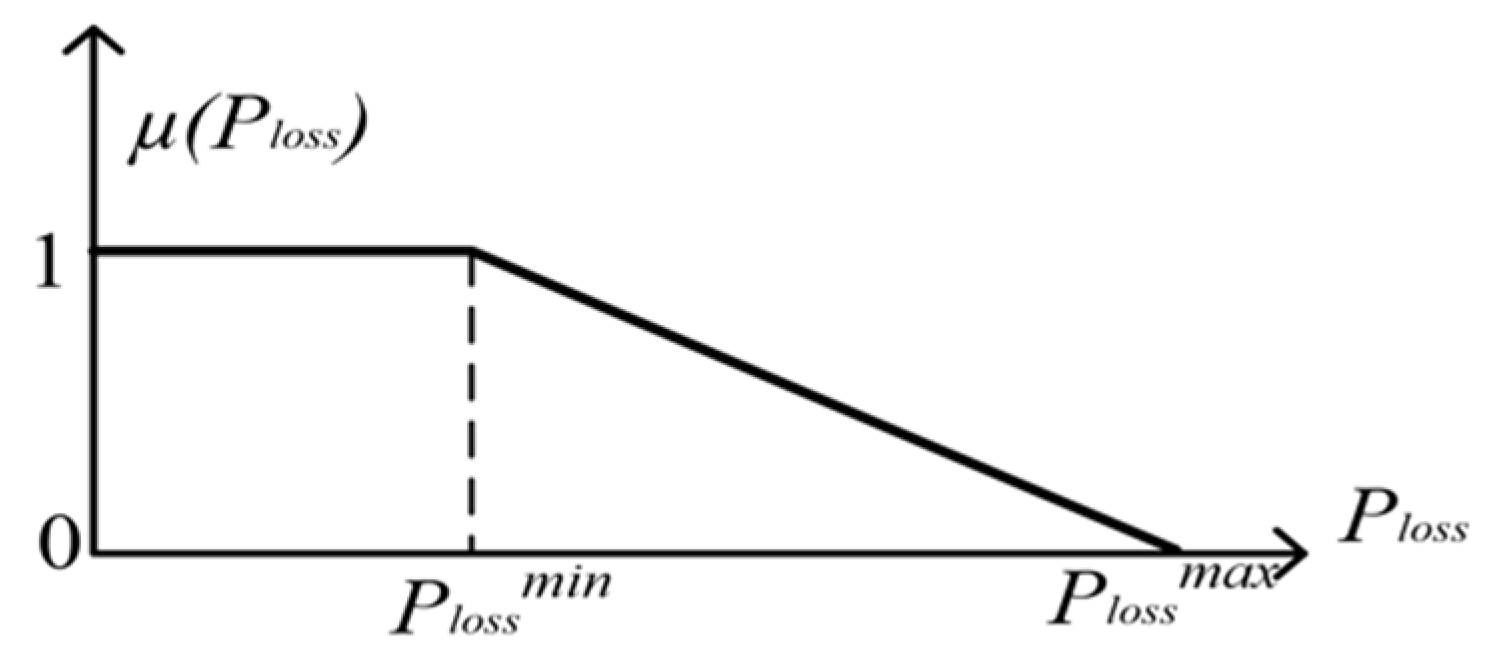
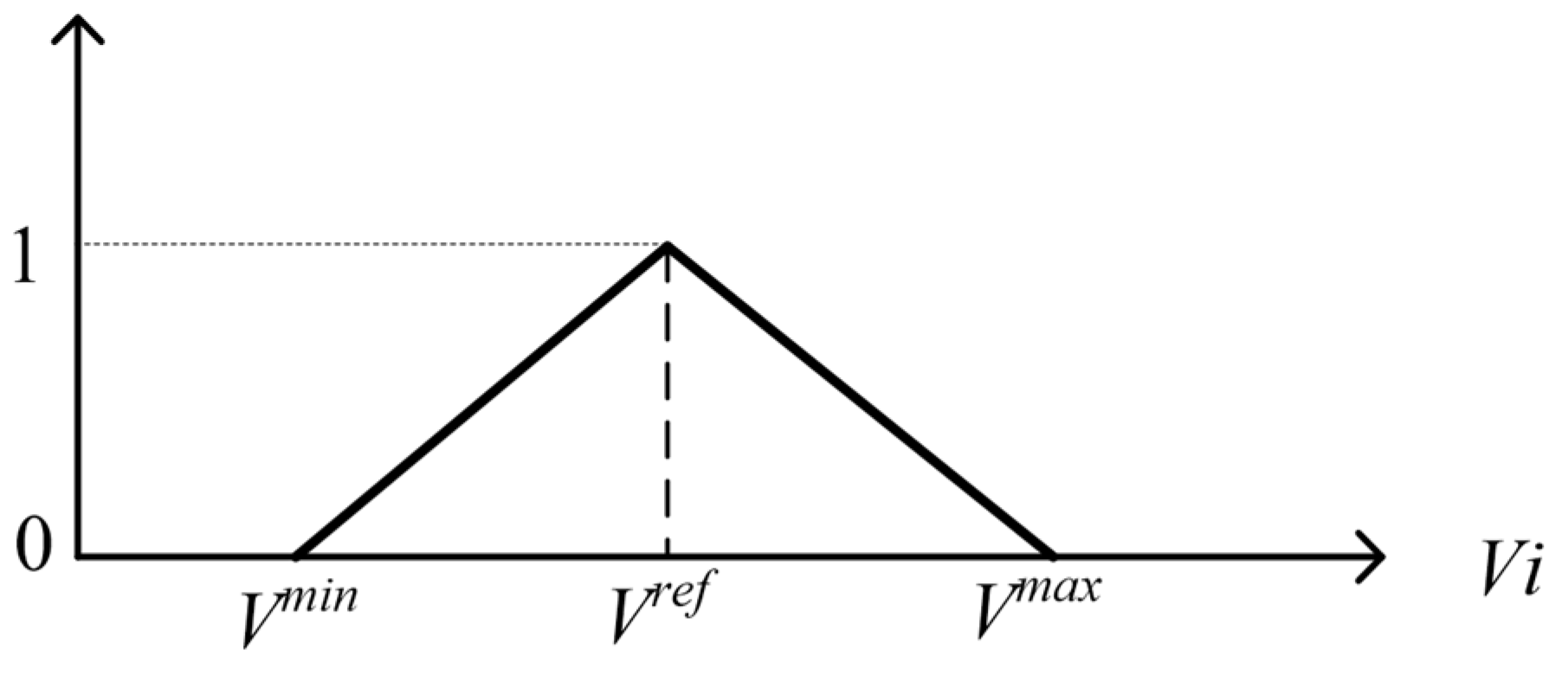
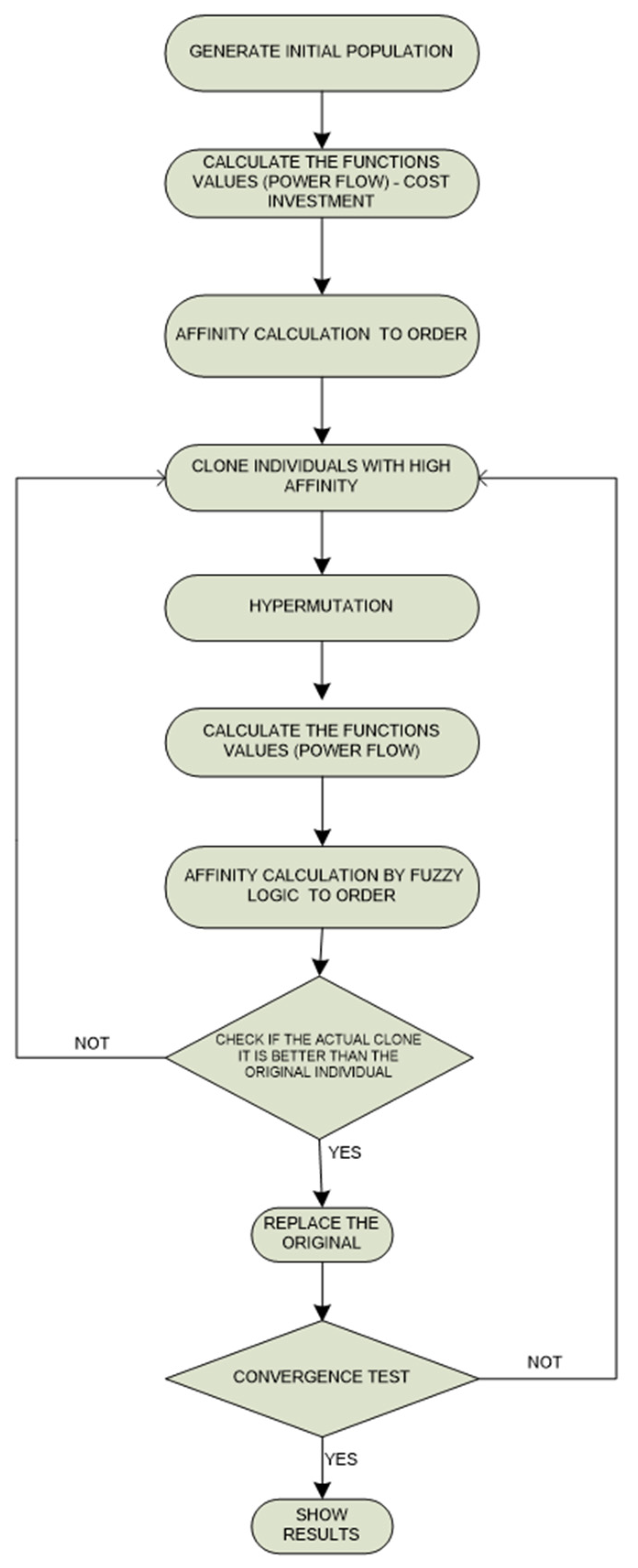
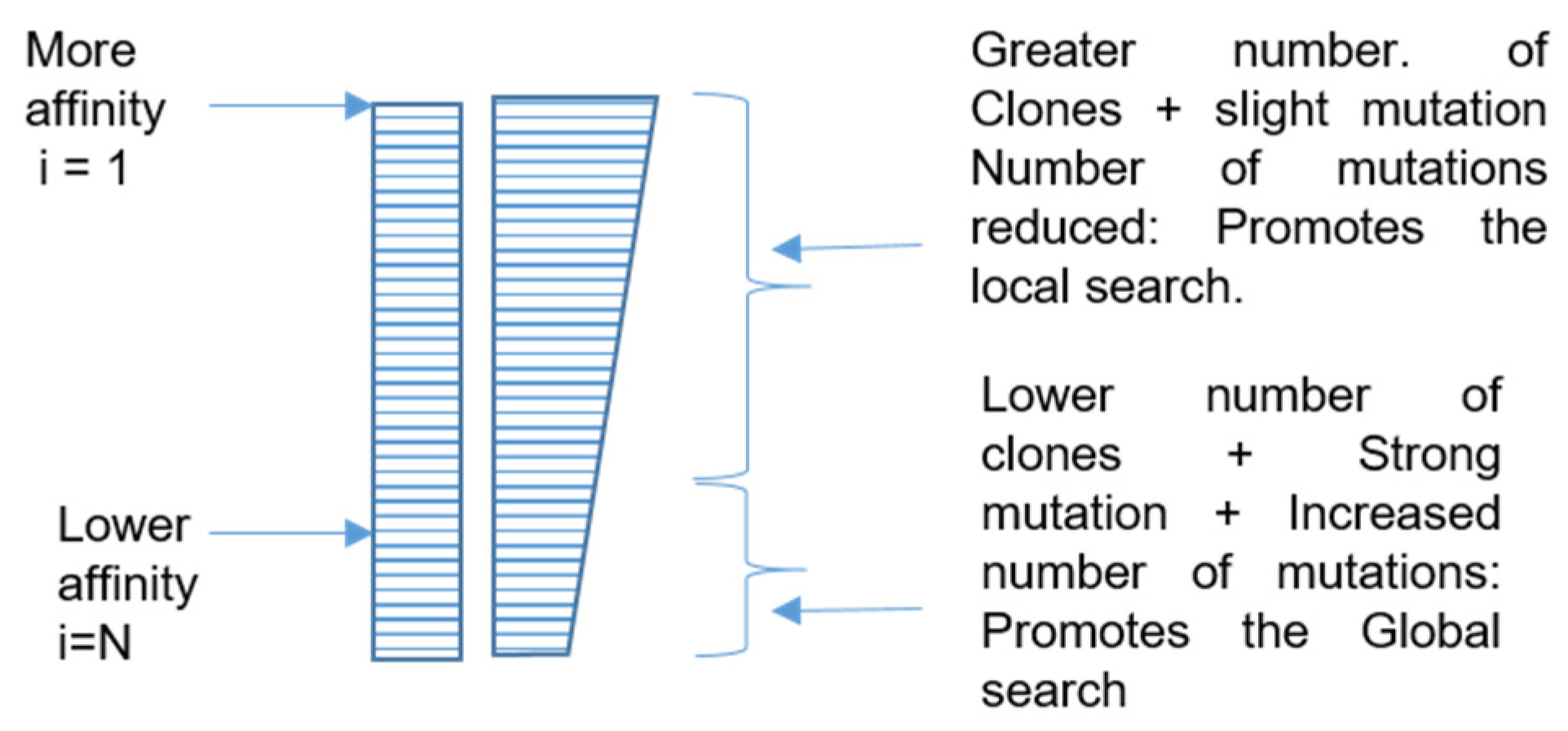
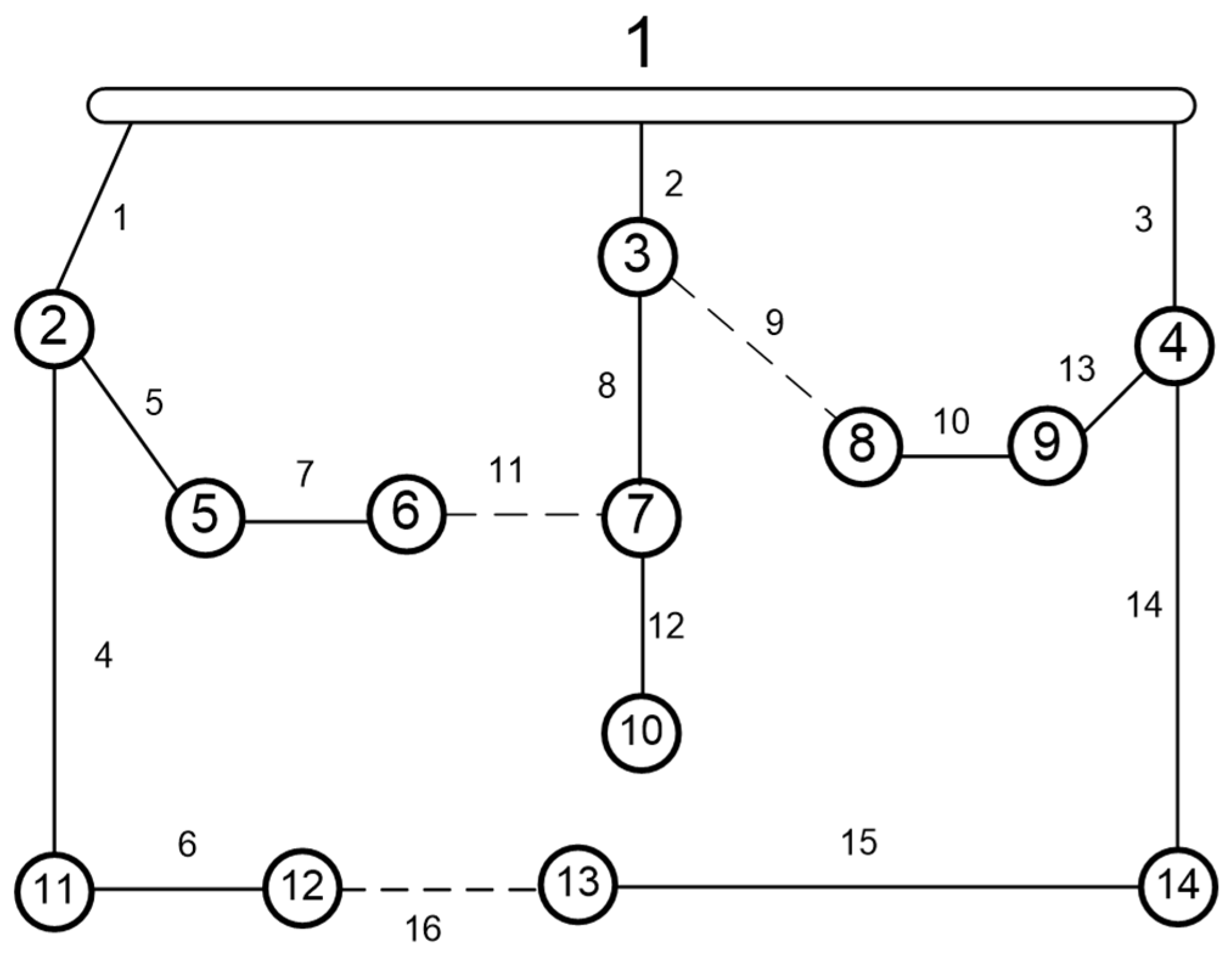
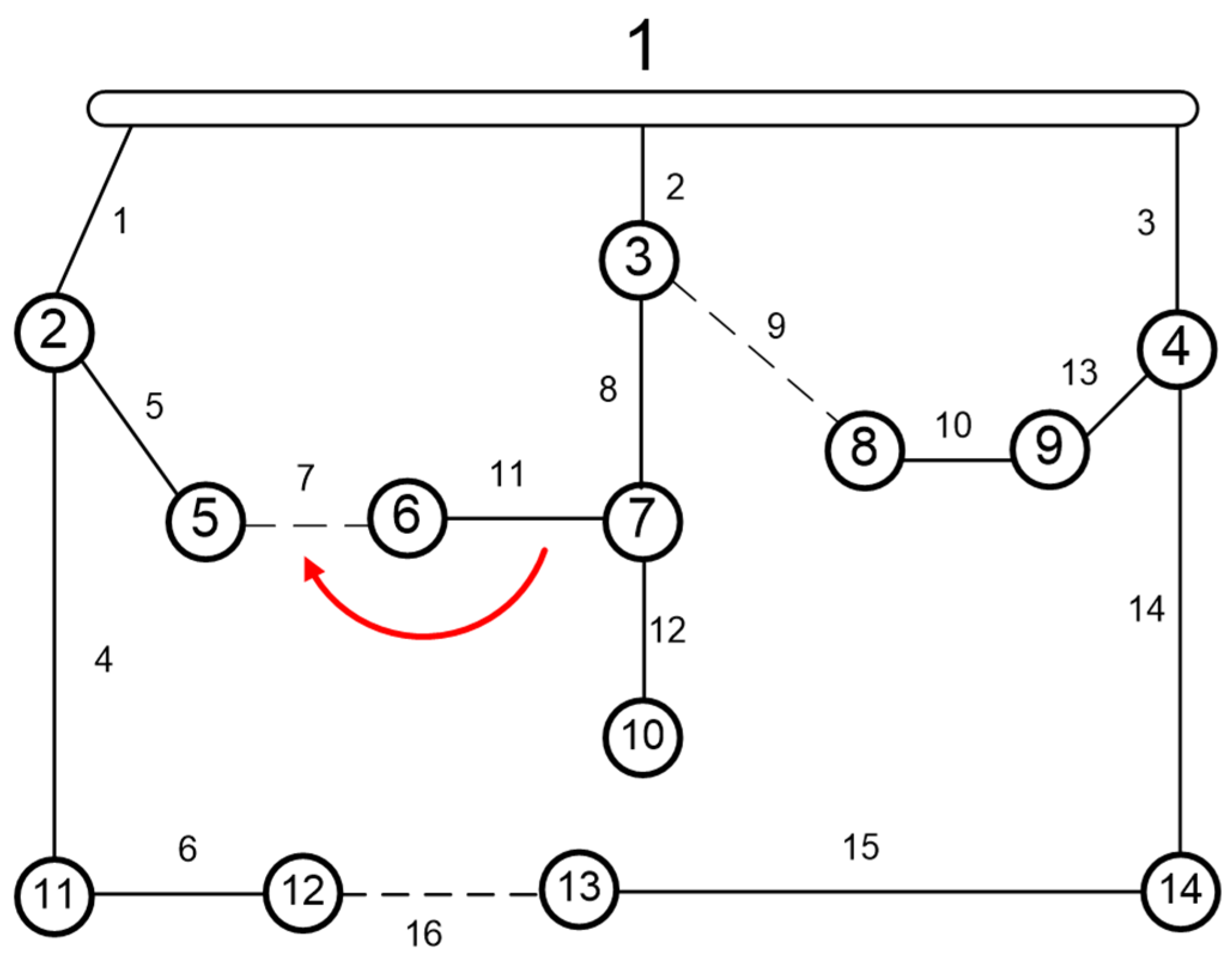
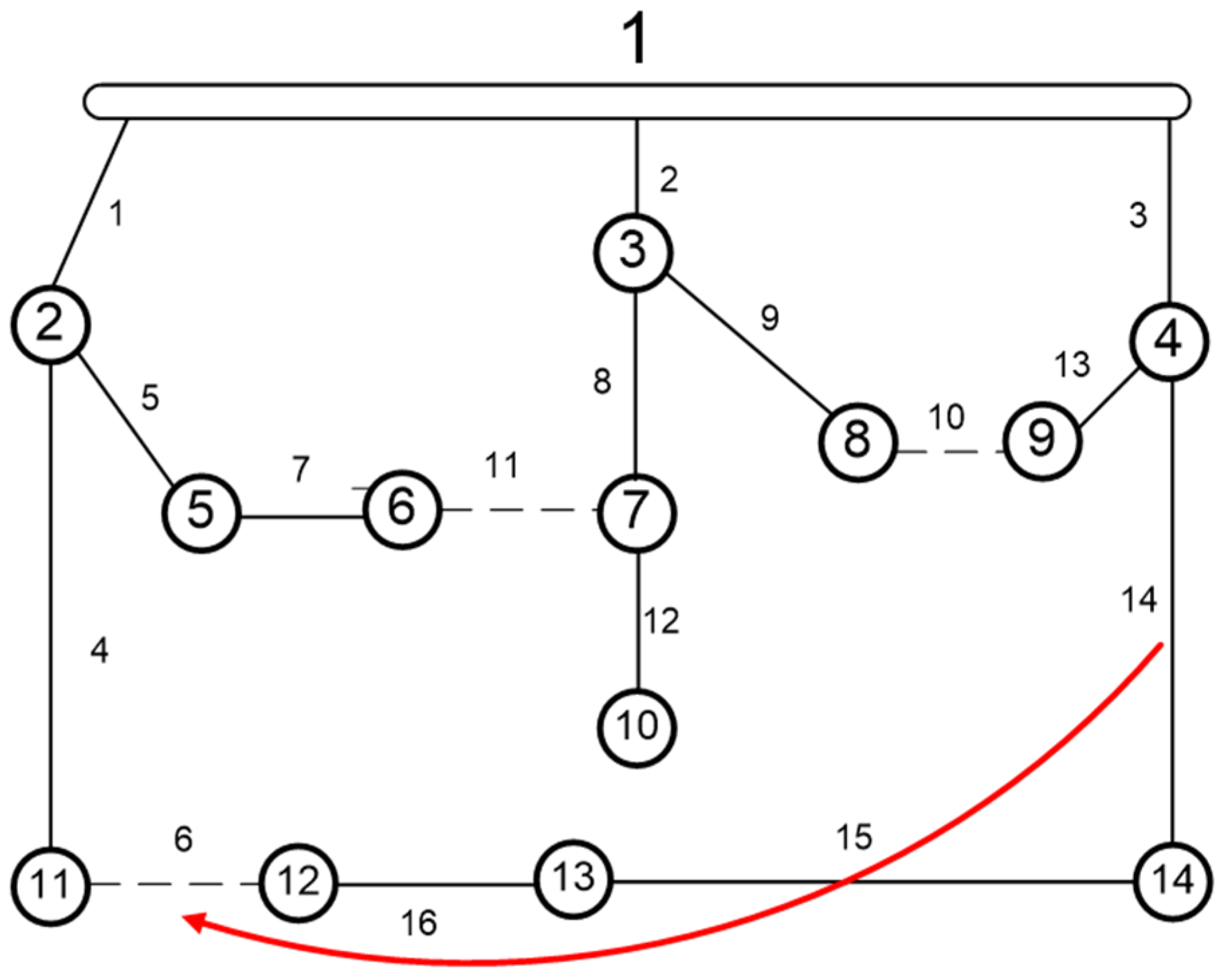
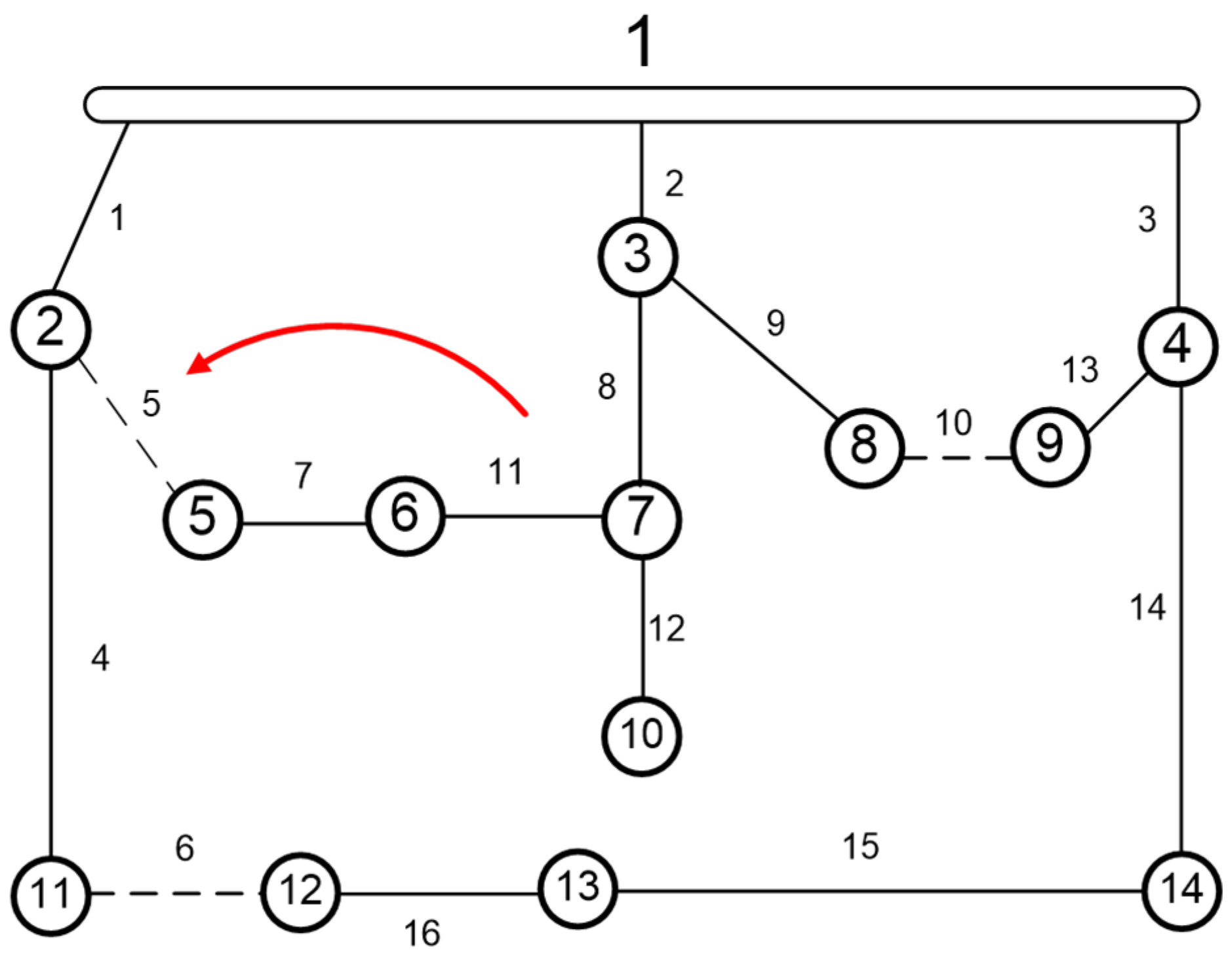





| Ref. | Open Switch | Loss (kW) | Average Convergence Time (s) | Average Convergence Iteration |
|---|---|---|---|---|
| 33–34–35–36–37 | 202.68 | data | data | |
| AIS | 7–9–14–32-37 | 139.55 | 0.84 | 8.1 |
| 7–9–14–32–37 | 139.55 | data | data | |
| [1,2,7,8,15,17,18,20,24,28,30,33,36,37] | 7–9–14–32–37 | 139.55 | 0.41 | 4.4 |
| Ref. | Open Switch | Loss (kW) | Average Convergence Time (s) | Average Convergence Iteration |
|---|---|---|---|---|
| Initial | 84–85-85–87-88–89-90–91-92–93-94–65-96 | 531.90 | ||
| AIS | 7–13-34–39-42-55–62-72–83-86–89-90–92 | 469.88 | 2 | 20.5 |
| EAIS | same | 469.88 | 0.8 | 5.8 |
| [7,13,23] | Same | 469.88 | -------- | --------- |
| Ref. | Open Switch | Loss (kW) | Average Convergence Time (s) | Average Convergence Iteration |
|---|---|---|---|---|
| Initial | 136–137–138–139–140–141–142–143–144–145–146–147–148–149–150–151–152–153–154–155–156 | 320.3 | ||
| AIS | 7–35–51–90–96–106–118–126–135–137–138–141–142–144–145–146–147–148–150–151–155 | 280.19 | 38 | 68 |
| EAIS | Same | 280.19 | 16 | 31 |
| [14,19,25]. | Same | 280.19 | ---------- | --------- |
| w1, w2, w3 | DG1 200 kW 100 kVAr | DG2 200 kW 100 kVAr | DG3 200 kW 100 kVAr | DG4 200 kW 100 kVAr | DG5 200 kW 100 kVAr | |
|---|---|---|---|---|---|---|
| 1 | 1, 0, 0 | x | x | x | x | x |
| 2 | 0.4, 0.3, 0.3 | x | x | x | x | x |
| 3 | 0.8, 0.1, 0.1 | x | x | x | x | x |
| 4 | 0.8, 0.1, 0.1 | bus 20 | bus 30 | Bus 42 | Bus 50 | Bus 80 |
| 5 | 0.8, 0.1, 0.1 | possible bus 20,21,22,23 | possible bus 30,31,32,33 | possible bus 42,43,44,45 | possible bus 50,51,52,53 | possible bus 80,81,82,83 |
| Open Switch | DG Location Bus | Loss kW | Feeder- (Branches) Current (pu) | Maximum Load Unbalance | Voltage Minimum (pu) | |
|---|---|---|---|---|---|---|
| 7–9–38–51–106–118–126–128–138 141–142–144–145 146–147–148–149 150–151–152–156 | 23–33–44–53–82 | 246,15 | 1-(1) 2-(17) 3-(39) 4-(63) 5-(75) 6-(85) 7-(99) | 0.0243 0.0308 0.0196 0.0179 0.0305 0.0184 | 26% | 0.9678 |
Publisher’s Note: MDPI stays neutral with regard to jurisdictional claims in published maps and institutional affiliations. |
© 2022 by the authors. Licensee MDPI, Basel, Switzerland. This article is an open access article distributed under the terms and conditions of the Creative Commons Attribution (CC BY) license (https://creativecommons.org/licenses/by/4.0/).
Share and Cite
Alonso, G.; Alonso, R.F.; De Souza, A.C.Z.Z.; Freitas, W. Enhanced Artificial Immune Systems and Fuzzy Logic for Active Distribution Systems Reconfiguration. Energies 2022, 15, 9419. https://doi.org/10.3390/en15249419
Alonso G, Alonso RF, De Souza ACZZ, Freitas W. Enhanced Artificial Immune Systems and Fuzzy Logic for Active Distribution Systems Reconfiguration. Energies. 2022; 15(24):9419. https://doi.org/10.3390/en15249419
Chicago/Turabian StyleAlonso, Guillermo, Ricardo F. Alonso, Antonio Carlos Zambroni Zambroni De Souza, and Walmir Freitas. 2022. "Enhanced Artificial Immune Systems and Fuzzy Logic for Active Distribution Systems Reconfiguration" Energies 15, no. 24: 9419. https://doi.org/10.3390/en15249419
APA StyleAlonso, G., Alonso, R. F., De Souza, A. C. Z. Z., & Freitas, W. (2022). Enhanced Artificial Immune Systems and Fuzzy Logic for Active Distribution Systems Reconfiguration. Energies, 15(24), 9419. https://doi.org/10.3390/en15249419











